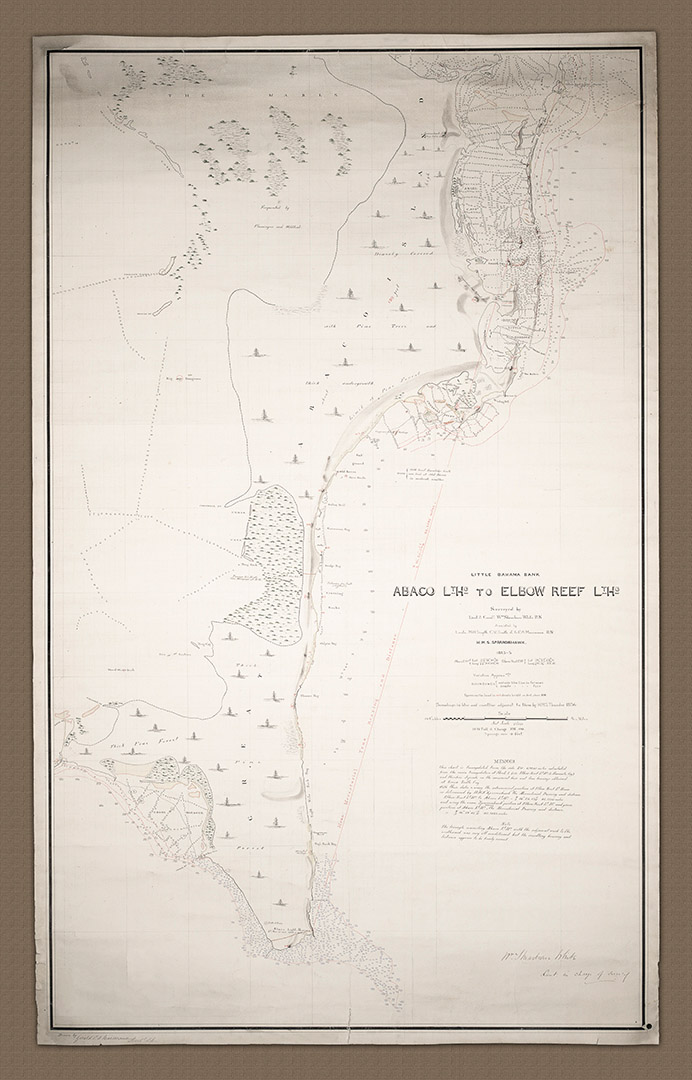A723 - Abaco Lighthouse to Elbow Reef Lighthouse
A detailed but delightfully presented survey chart of an important region of the Bahamas. The 29 islands which make-up the area we now know as the Commonwealth of the Bahamas were the site of Christopher Columbus's first landing back in the 1490s. They were first colonized by British settlers during the 17th century, and were officially declared a Crown Colony in 1718.
- 1883-5 & 1886
- Lt & Commander William Shearburn White
- h52" x w33"
- P
The Bahama island's proximity to the North American mainland and Florida ensured that they have a special relationship with both America and Britain and the story of the Bahamas is very much one of new beginnings: Following the Revolutionary War of 1775-1782, the Islands of the Bahamas, like the island colonies in the Caribbean and Bermuda, remained under British control and provided shelter for thousands of pro-loyalist's supporters who were no longer able to live on the American mainland under the new government.
These emigrants immediately set-up a new plantation economy amongst the islands, and a major trade link with the British homeland was born. In the 19th century, as part of battle to secure the abolition of the slave-trade, many liberated Africans were relocated in the region by the Royal Navy and given a new start amongst the islands.
The Abaco Islands consist of Great Abaco and it's outer reef Elbow Reef. Throughout the 18th and 19th centuries they were sparsely populated and economically dependent upon the trades of boat building and ship-wrecking. The practice of 'salvage'(or 'wracking') by ship-wreckers in the islands was a well-organized and lucrative business which accounted for the employment of up to half of all able-bodied men in the region, and over 300 vessels were licensed into the trade.
The islands were on the main shipping route between the Caribbean and Florida. All 'salvaged' cargo was considered to be 'imported' goods and was sent to Nassau for auction. The government and its agents would take up to 50% of the value, with the remainder going to the 'wrackers' and the ship owners. Around the middle of the 19th century records show that up to one ship a week was wrecked on the reefs of the Abaco Islands. Perhaps not surprisingly, there is evidence of the wrackers deliberately setting lights to attract passing ships onto the reefs rather than away from them.
The construction of the Elbow Reef lighthouse at Hope Town in 1864 was no smooth affair with local wrackers doing all they could to interrupt its construction, including sabotage, sinking construction supply barges, and withholding drinking water to construction workers. The site chosen for the construction of the Lighthouse was, ironically, on the exact spot which had been the most profitable for the wrackers, at the entrance to the harbour.
The other lighthouse featured on the survey is known as the 'Hole in the Wall' lighthouse on the southern tip of Great Abaco. It was named after a hole in the wall of a rocky tidal outcropping by the sea. Construction was completed the same year that the soundings (shown in blue on the chart) for the southern part of this survey were made by HMS Thunder between November and April 1836.
The chart makes reference to the vegetation and wildlife on the islands and, as well as including small notes as to natural navigational features such as prominent hills and trees and it even shows an area frequented by flamingos and wildfowl.
Land heights at various points are marked in red. Marsh Harbor, now the major ship building town and 'gateway' to the islands, shows little sign of development.
The major part of survey was undertaken by Lt & Commander William Shearburn White, assisted by Lts Smyth & Smith utilizing HMS Sparrowhawk which was a specially built survey schooner. That the British Navy had, by the mid 1800s, started to commission specialist survey vessels was a mark of the importance attached to this level of information gathering.
- Abaco Lighthouse to Elbow Reef Lighthouse


